Activity 1: Getting to Know Aquatic Animals
Topic: Youth will be introduced to aquatic animals that are related to fisheries in Maine.
Time: This lesson should take approximately 45-60 minutes to complete.
Video: Activity 1: Getting to Know Aquatic Animals (YouTube)
Learning Outcomes:
At the end of this activity, youth should be able to…
- List some of the aquatic animals found in Maine.
- Explain where some of Maine’s aquatic animals are found using a map.
- Defend their reasoning of where they put animals using evidence.
Background Information for Facilitator:
Because Maine has a large coastline (we have more coastline than California!), we have access to a lot of fish, like salmon and cod, as well as other aquatic species, such as lobster and clams. It is no surprise that Maine is a big contributor to fisheries and fish markets. Not all the fish and aquatic animals fished in Maine are found in the same spot. For example, clams are found in the intertidal zone (covered in water at high tide and exposed at low tide), whereas cod and haddock are ground-dwelling fish in the ocean.
The intertidal zone is an important part of the coastal ecosystem. Picture Maine’s rocky coastline; close to the water the rocks are getting splashed with water, which sometimes flows over them, and as the terrain reaches land, the rocks increase in elevation. At high tide, the spaces between the rocks fill with water creating pools of water, called tide pools. At low tide the water recedes back into the ocean, leaving the tide pools, a habitat for different creatures: crabs, sea urchins, starfish, and lobsters. To learn more about the different zones within the intertidal zone and what creatures live there, check out the Additional Resources section.
On the information sheet, you may notice that it states that both cod and haddock populations off the coast of Maine are decreasing. Cod populations began decreasing in the early 1980s due to overfishing. Although quota limits and catch limits were put in place, the populations continued to decline, meaning that other factors were contributing to this trend. Researchers found that the quick warming of coastal Maine ocean temperatures was the leading cause, making the habitat less liveable for the cod. The warming temperatures decreased the number of spawning cod and the probability of them living through adulthood. Visit the Warming waters a major factor in Gulf of Maine cod collapse page (NOAA Research News website) for more information. As another ground-dwelling species, haddock has a similar history of being overfished. However, haddock populations don’t seem to be hit as hard from warming temperatures in the Gulf of Maine.
Materials:
- Fish Memory Game Cards
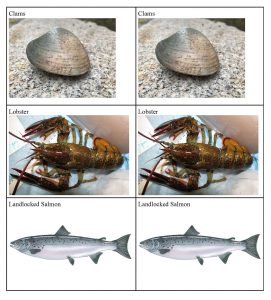
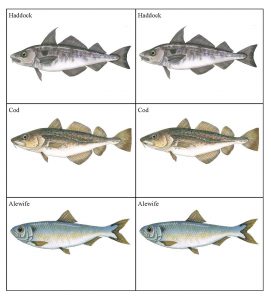
- Fish Memory Game Information Sheets
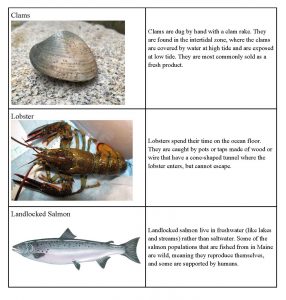
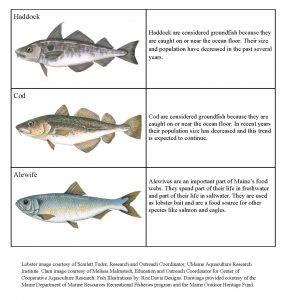
- Zone map
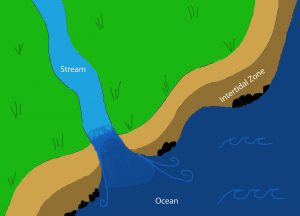
- Whiteboard
- Paper
- Pencils
- Colored pencils
Vocabulary:
- Aquatic = relating to water
- Intertidal zone = the shore area that is covered by water at high tide and exposed at low tide (i.e. sand beaches or muddy flats)
- Diadromous = fish that migrate between fresh and saltwater (i.e. alewife)
- Landlocked salmon = a species of salmon that live in lakes and ponds in eastern North America (they are related to Atlantic salmon, which you may be more familiar with)
Methods:
Engage
- Explain to youth what they will be doing today, then lead them through a brainstorming exercise. “Today we’re going to be exploring the types of aquatic animals that are fished for in Maine. Before we start, I want to know what types of fish or other aquatic animals you know are fished for in Maine.”
- Have youth share as a whole group what they know and record their ideas on the whiteboard (or they can come up to the board and record themselves!).
- If needed, here are a couple of prompts you can share to get youth thinking: “Have you ever gone fishing? Do you remember what you caught?” “Consider the types of water we can fish in: lakes, ponds, rivers, and the ocean.” “If you have ever gone to a grocery store that has a fish or seafood section, what have you seen?”
Explore
- Split youth up into groups of 3.
- Give each group a set of cards, an information sheet, and a zone map.
- Explain to the youth that this is a game of matching. In each set of cards, there are several aquatic animals that are fished for in the state of Maine. There are two cards for each animal. Their goal is to find the matches.
- Have youth shuffle the cards so they can’t see the animals.
 Have them organize the cards face down in a grid formation, so they are in straight lines and do not touch (see right).
Have them organize the cards face down in a grid formation, so they are in straight lines and do not touch (see right).
- You can use the whiteboard to show youth what this looks like.
- Each person in the group will get a turn to flip over TWO cards. If the cards match, that person gets to (1) keep those cards, (2) find the animal on the information sheet, and (3) read it out loud to the rest of the group.
- Then, have youth collaborate as a group and place the animal on the zone map where it would most likely be found. For example, on the information sheet it says “[clams] are found in the intertidal zone,” so youth should place the clam card(s) on the intertidal zone on the map. If youth have trouble here, point them to the information sheet where it speaks to where they are found. Looking at the sheet and map side by side can be helpful.
- If you don’t get a match, you flip the cards over and the next person goes.
- Whether you get a match or not, it’s the next player’s turn.
- Have youth continue to play until all the cards are matched.
- Some groups may finish quicker than others. If a group is quick and is done early, they can begin to play again (first shuffling their cards to mix them up! Facilitators should walk around and try to give ‘time left’ updates (1 minute left/the last turn), even if some groups aren’t completely finished).
- Once youth are done playing, ask them to collect the cards in a pile so you can go around and collect them.
- Compare the aquatic animals brainstormed before this activity and the animals that were used in the game.
- “What new animals were you introduced to? What animals surprised you?”
- “Looking at the animals and where they are found, do you see any patterns?” Below there are a few listed. They can be used to prompt youth if they are confused about what you are asking or having trouble seeing them. Patterns can be about anything, what the animal looks like, where they are found or how they are caught!
- Clams and lobsters have unique ways of being caught (dug with a clam rake and caught with a trap, rather than a net or line).
- Cod and haddock populations are both declining.
- Besides the lobsters, the fish don’t seem to have very bright colors.
Explain
- All of the aquatic animals we explored and learned about are caught or fished for in the state of Maine and are used for either bait to catch other fish or for food.
- Youth may have noticed reading the information sheet that aquatic animals are not all found in the same place. Some of them, like haddock and cod, are found near the ocean floor. Clams, on the other hand, are found in the intertidal zone, a shore zone that is covered by water at high tide and exposed at low tide.
- Use the map to point out these various places and have youth notice the differences between them.
- Identify the three different places on the map: a stream, the intertidal zone, and the ocean.
- “How are the ocean and stream similar?” They are both water and they are both blue on the map. “How are the ocean and stream dissimilar?” Youth may know that the stream contains freshwater and the ocean contains saltwater. “How is the intertidal zone dissimilar from the stream and ocean?” It’s not always covered by water, you can walk on it and you can see it (hard to see underneath the water).
- If the youth are less familiar with the ocean or coast, it may help to explain that the end of the intertidal zone is where the seaweed, shells, and wood debris ends up (this ocean debris is where the water is at high tide, so the tide pushes it all up). If the youth have ever been to the beach the intertidal zone and is usually more wet and firm. The really soft and light sand usually sits above the intertidal zone.
- Use the map to point out these various places and have youth notice the differences between them.
Elaborate
- Allow youth to choose one of the aquatic species that is fished for in the state of Maine to draw.
- Hand out paper, pencils, and coloring materials.
- Give youth time to draw their creature and color it in. Using the information in the sheet, youth can also draw where they would be able to find this creature (ocean, intertidal zone, river/fresh water). The zone map can be used to reference where the animals are found as well.
- Option: You may choose to share the video in the Additional Resources section (#4) from the Marine Stewardship Council to highlight the importance of fisheries, as well as some of the obstacles and solutions.
- Allow youth to share some of their drawings with the group.
- You can start this as soon as the youth start to finish, this will allow some youth to share and listen while others are continuing to draw.
- Keep the sharing time to a minute or two, this will allow most all youth to share. If you cannot get to everyone, allow the youth to leave the picture with you so you can appreciate it and give it back at the next meeting.
- To engage with youth about their drawings you can ask questions or make observations: “Why did you include __?” “I notice you included a lot of detail about __ (colors, scales, habitat).” “Can you explain your thought process while drawing?”
Evaluate
Discuss the following questions as a whole group.
- “What was it like to work in a group?”
- “What was it like to have to collaborate and agree upon a spot to put the animals on the map?”
- “Do you have any new thoughts or feelings about aquatic animals?”
- “How about when you were drawing them?”
Additional Resources:
- Article on declining cod populations from NOAA: Warming waters a major factor in Gulf of Maine cod collapse (NOAA Research News website)
- This virtual storyboard paints a picture of what the intertidal zone is, what lives there, and why it is important: The Rocky Intertidal Zone of the Gulf of Maine (Research in Ecology, Evolution and Marine Biology, Bowdoin College, 2019 website)
- Interactive webpage that allows youth to explore the different zones, the creatures that live there and answer some questions about them: Life in the Intertidal Zone (Ocean Explorer NOAA website)
- Commercial Fisheries State of the Gulf of Maine Report (PDF), includes the history of fisheries in Maine, which types of fish and organisms are commercially fished in Maine, as well as the threats, impacts, and actions of fisheries. This may be useful for specific facts and information, and for more background on commercial fishing, specifically in Maine.
- An educational short film on fisheries, “My dad the fisherman,” on the Film and clips page (Marine Stewardship Council). This video inspired the flow of this lesson, incorporating both factual information and socio-cultural connections to commercial fisheries.
Supported by National Science Foundation award #OIA-1849227 to
Maine EPSCoR at the University of Maine.

This project is part of the RII Track-1: Molecule to Ecosystem: Environmental DNA as a Nexus of
Coastal Ecosystem Sustainability for Maine (Maine-eDNA) at the University of Maine.
